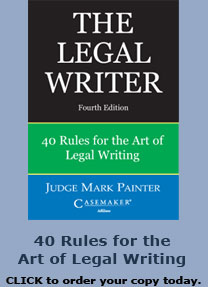Did Bad Writing Doom the EU Constitution?
By Judge Mark P. Painter
|
Both the French and the Dutch have voted down the European Union Constitution. Perhaps they actually tried to read it. Here’s a typical paragraph: Under the principle of subsidiarity, in areas which do not fall within its exclusive competence, the Union shall act only if and insofar as the objectives of the proposed action cannot be sufficiently achieved by the Member States, either at central level or at regional and local level, but can rather, by reason of the scale or effects of the proposed action, be better achieved at Union level. The institutions of the Union shall apply the principle of subsidiarity as laid down in the Protocol on the application of the principles of subsidiarity and proportionality. National Parliaments shall ensure compliance with that principle in accordance with the procedure set out in that Protocol. Compare the Tenth Amendment in our Bill of Rights: The powers not delegated to the United States by the Constitution, nor prohibited by it to the States, are reserved to the States respectively, or to the people. William DuBay of Impact Information (a fellow plain-language crusader) has pointed out the difference between our Constitution and theirs: The U.S. Constitution contains 4,000 words in 11 pages and seven articles, all written at a democratic 9th-grade level. The European Constitution is a badly organized, 855-page, 156,447-word document written at the 16th-grade level. The first and most important part is missing a title. Some of the 465 articles ended up in the wrong sections. Of course, we cannot lord it over the Europeans too much, because our lawyers usually write too many words. And most of our statutes are awful. But considering the drafters of the two constitutions, we had the better group. More Examples In doing some research about William Howard Taft, I found perhaps the most egregious violation of my Rule 8 – Write Short Paragraphs. In one 6th Circuit opinion, Judge Taft wrote a 10-page paragraph! It contains 1,947 words and 66 sentences – about twice the size of this article in one paragraph. The average sentence length is 30 words, versus a goal of 18; and it’s 28 percent passive, versus 18 percent – see the 1818 Rule. And in another writing gem, in the Supreme Court no less, he was able to construct a 327-word sentence: In his amended bill the complainant averred that he deraigned his title from one Mehaley Watson, a Creek citizen, to whom was allotted the land in question, that a patent was issued in her name signed by the principal chief of the Creek Nation and approved by the Secretary of the Interior, that she died in October, 1908, before the issue of the patent in March, 1909, that she was an illegitimate child of the defendant Hannah C. Barnett, a Creek of the full blood, who was her heir and inherited the land in question, that on March 22, 1909, in consideration of $500, the mother executed and delivered a warranty deed for the tract to one B. O. Sims, that on the same day the deed to Sims was approved by the County Court of Hughes County, Oklahoma, the court having jurisdiction to settle the estate of Mehaley Watson deceased, that Sims conveyed to Brannan, that Brannan conveyed to Berrian and others from whom by some eleven mesne conveyances, the details of which were set out in the bill, the land was conveyed, in March, 1913, to one R. S. Litchfield, that, the question then having arisen whether Mehaley Watson was not a resident of Okfuskee County, instead of Hughes County, when she died, Mrs. Barnett and her husband filed their petition in the County Court of Okfuskee County asking approval of her deed of March, 1909, to B. O. Sims, and obtained the approval of that court accordingly in consideration of $2000 paid her by Litchfield; that Sims on the same day made and delivered a quitclaim deed of the land to Litchfield, that, by several mesne conveyances set forth, the tract became ultimately vested in the complainant, and that complainant in May, 1914, leased the land to the Prairie Oil and Gas Company for oil and gas purposes, which entered upon the land and was operating wells thereon and paying complainant rentals and royalties. And that was all too typical of a stilted, mind-numbing style. But Taft was not alone – many of his fellow judges wrote as badly. Perhaps we have progressed some in the last century or two. But we still have a long way to go. Three or four sentences are usually enough for a paragraph; there is no set rule. But never write a paragraph of more than one double-spaced page, and very seldom that long. Readability
Several people have asked me how I determine the readability statistics that I list at the end of most columns. Open Spellcheck and look at the bottom of the screen for Options. Click on that and check “show readability statistics” – it’s the very last box on that screen. While you’re there, look at the other settings and tune them to your preferences. Readability statistics for this column: 7.5 words per sentence, 0 percent passive voice, readability score 62. (Remember the 1818 Rule – no more than an average of 18 words per sentence and 18 percent passive-voice sentences.) That’s for my text only. Taft’s statistics: 327 words per sentence, 0 percent passive voice, readability score 0. |
____________________________________
Mark Painter has served as a judge on the Ohio First District Court of Appeals for 10 years, after 13 years on the Hamilton County Municipal Court. He has served as an Adjunct Professor at the University of Cincinnati College of Law since 1990. Judge Painter is the author of five books, including The Legal Writer: 40 Rules for the Art of Legal Writing. The third edition o that book was published in May. It is available from http://books.lawyersweekly.com. Judge Painter has given dozens of seminars on legal writing, and will give his six-hour legal writing seminar in September in Raleigh, Charlotte, Nashville, and Memhis. Contact him through his website www.judgepainter.org.








